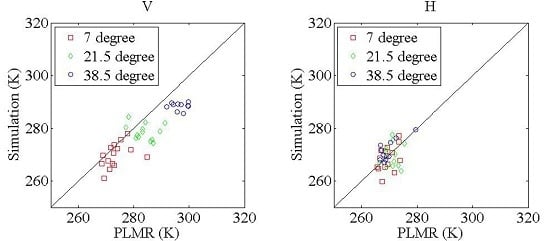Calibration of the L-MEB Model for Croplands in HiWATER Using PLMR Observation †
Abstract
:1. Introduction
2. Data
2.1. The Airborne PLMR Microwave Brightness-Temperature Data
| Observation Date | Flight Height | Spatial Resolution | Data Source |
|---|---|---|---|
| 30 June 2012 | 2.50 km | None | doi:10.3972/hiwater.013.2013.db |
| 3 July 2012 | 0.35 km | 100 m | doi:10.3972/hiwater.014.2013.db |
| 4 July 2012 | 1.00 km | 300 m | doi:10.3972/hiwater.015.2013.db |
| 5 July 2012 | 2.00 km | 600 m | doi:10.3972/hiwater.016.2013.db |
| 7 July 2012 | 2.00 km | 600 m | doi:10.3972/hiwater.017.2013.db |
| 10 July 2012 | 2.50 km | 750 m | doi:10.3972/hiwater.018.2013.db |
| 26 July 2012 | 2.30 km | 700 m | doi:10.3972/hiwater.019.2013.db |
| 1 August 2012 | 1.00 km | 300 m | doi:10.3972/hiwater.020.2013.db |
| 2 August 2012 | 2.30 km | 700 m | doi:10.3972/hiwater.021.2013.db |
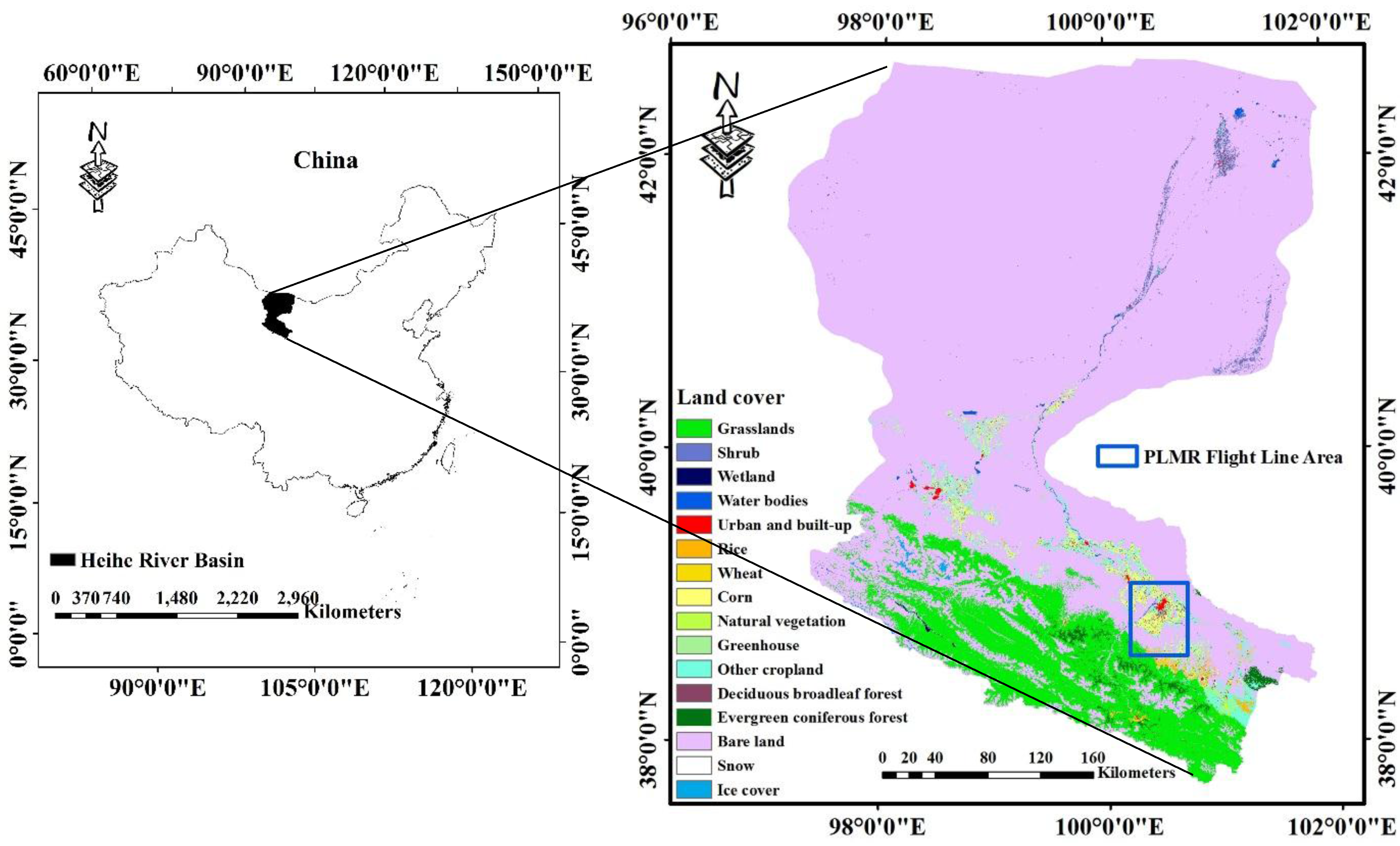
2.2. Field Observation Data
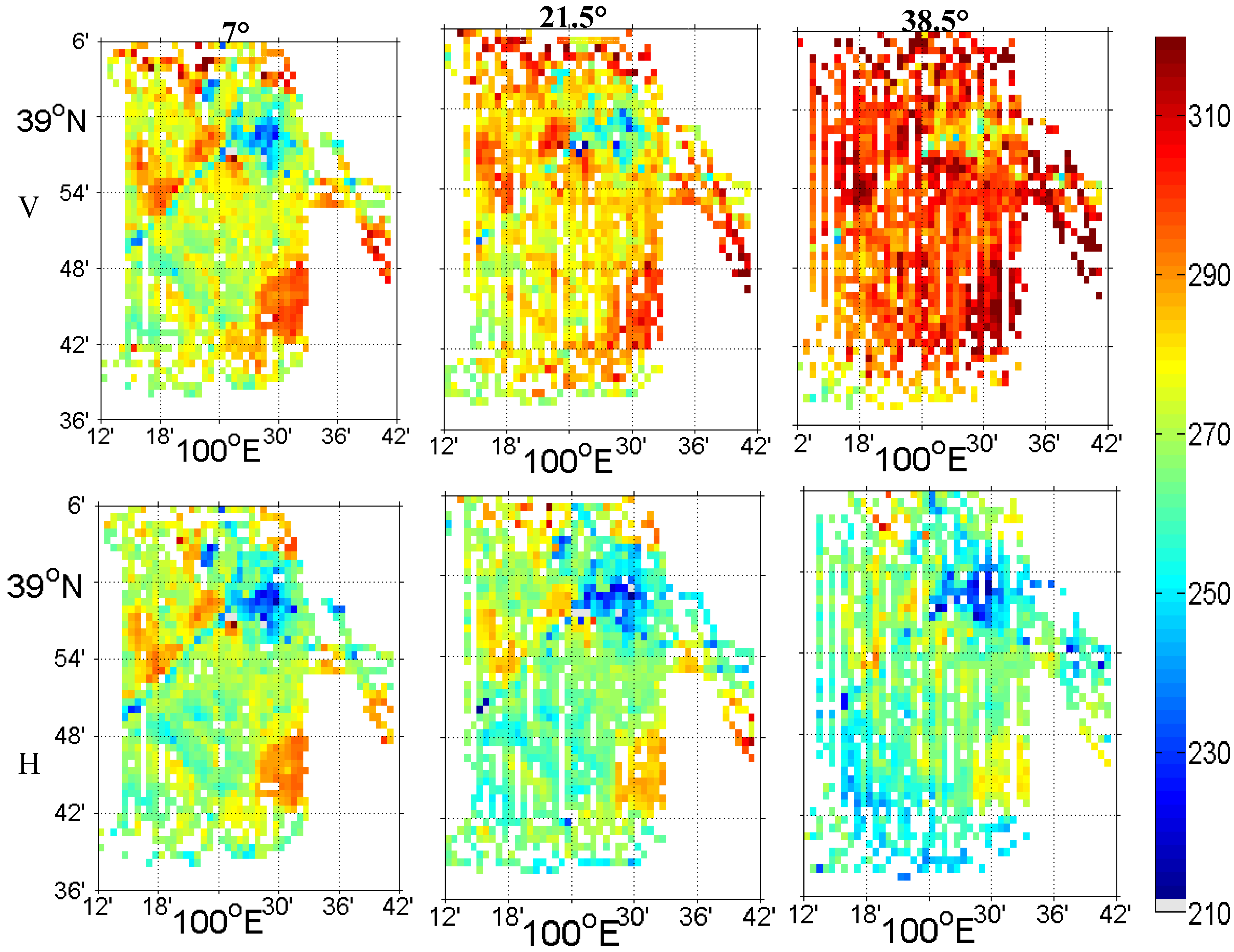
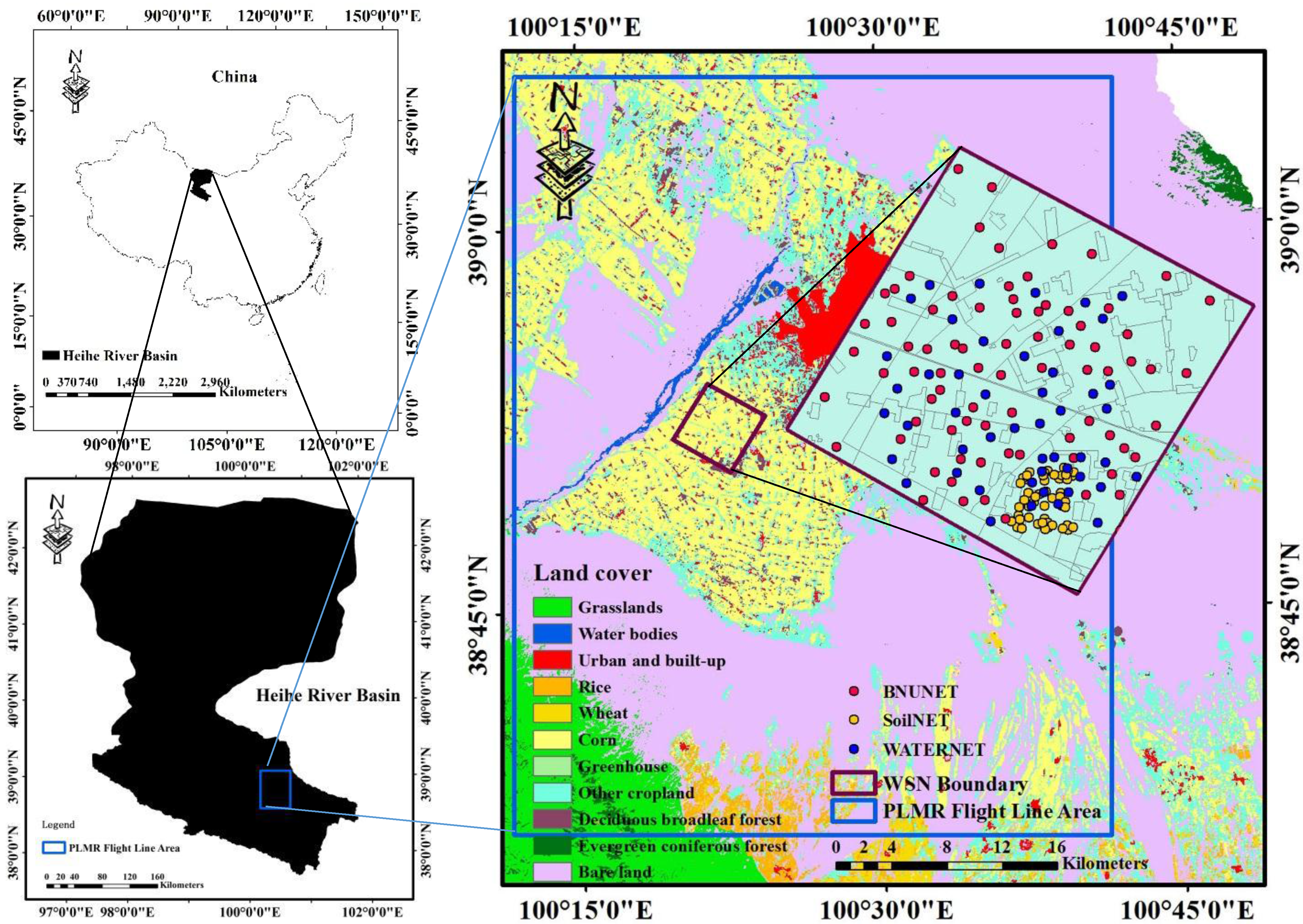
3. The L-MEB Model
3.1. Soil Effective Temperature
3.2. Soil Reflectivity
3.3. Vegetation Effects
4. Sensitivity Analysis of L-MEB
| Input Parameter | Ranges | Mean |
|---|---|---|
| soil moisture (cm3/cm3) | 0.14–0.46 | 0.26 |
| Soil temperature at 4 cm (°C) | 21.86–38.04 | 27.42 |
| Soil temperature at 10 cm (°C) | 18.85–29.44 | 23.94 |
| LAI | 1.75–5.25 | 3.50 |
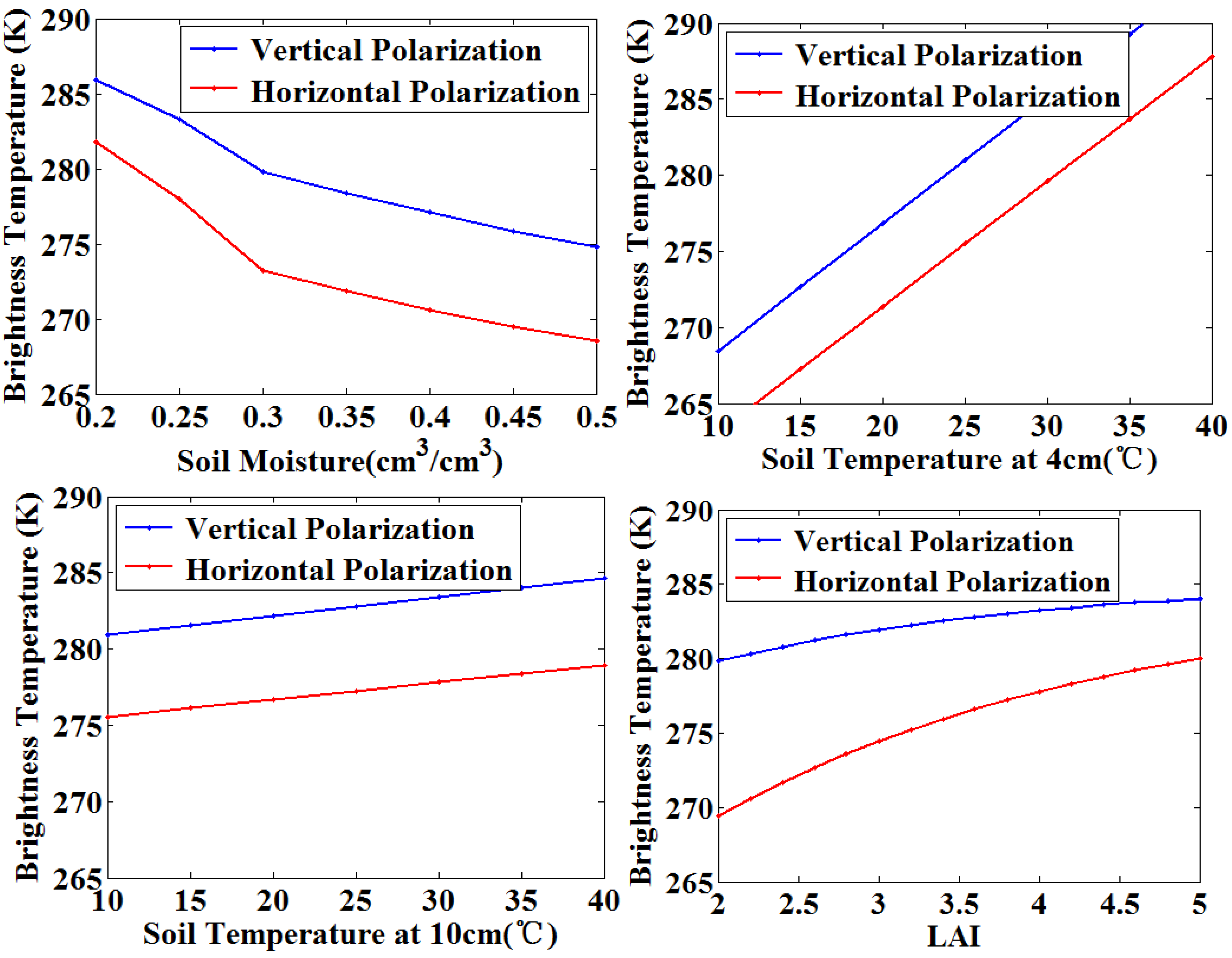

5. Results and Discussion
5.1. Calibration of the Semi-Empirical Parameters
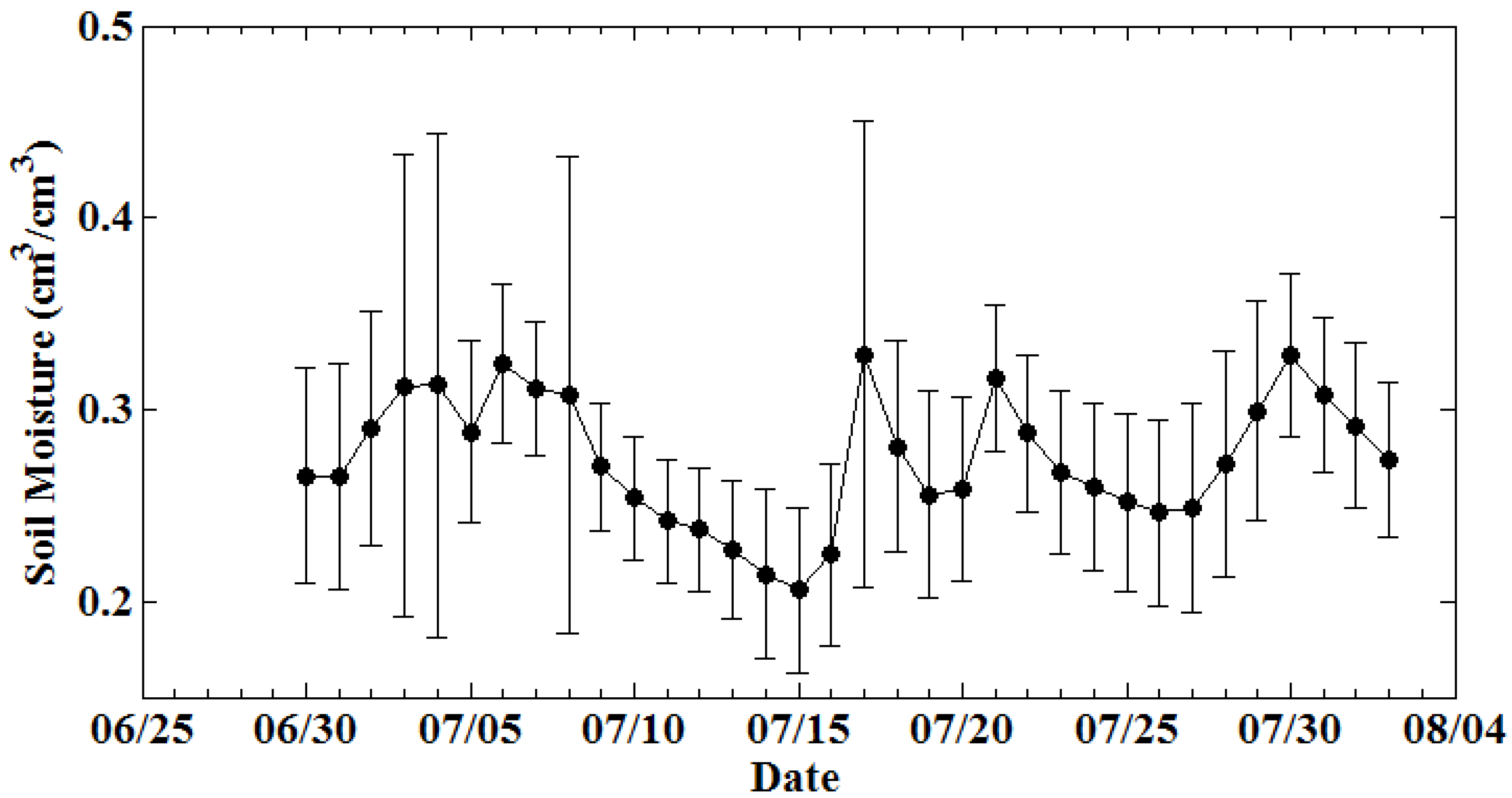

| Qs | NH | NV | Cpol | b | ω |
|---|---|---|---|---|---|
| 0.0 | –1.0 | –4.0 | 3.0 | 0.12 | 0.05 |
5.2. Validation of the Calibrated Parameters
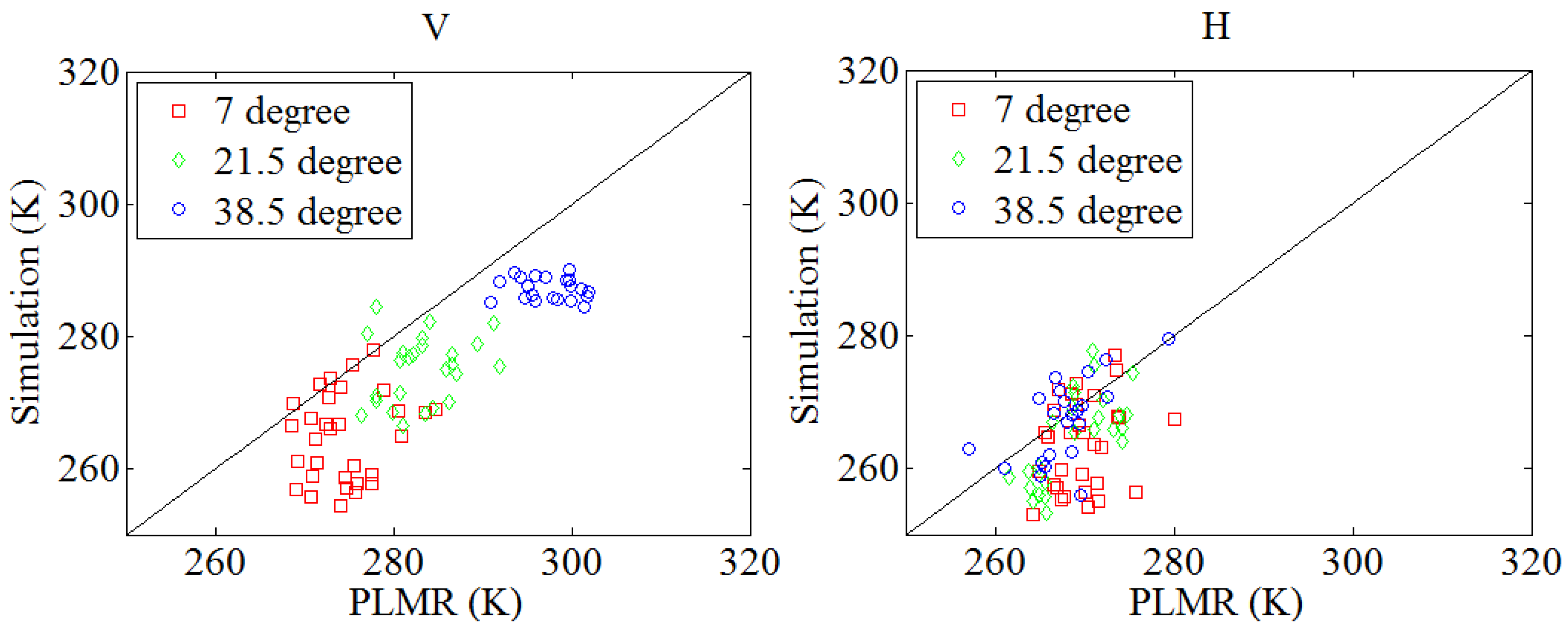
| θ | RMSE (V) | RMSE (H) | R (V) | R (H) |
|---|---|---|---|---|
| 7° | 12.15 K | 9.24 K | 0.180 | 0.264 |
| 21.5° | 9.05 K | 5.83 K | 0.241 | 0.696 |
| 38.5° | 9.16 K | 4.06 K | –0.116 | 0.614 |
| θ | RMSE (V) | RMSE (H) | R (V) | R (H) |
|---|---|---|---|---|
| 7° | 6.05 K | 4.23 K | 0.438 | 0.460 |
| 21.5° | 7.26 K | 4.67 K | −0.208 | 0.038 |
| 38.5° | 7.05 K | 2.70 K | −0.008 | 0.779 |

6. Conclusions
Acknowledgments
Author Contributions
Conflicts of Interest
References
- Delworth, T.; Manabe, S. The influence of potential evaporation on the variability of simulated soil wetness and climate. J. Clim. 1988, 13, 2900–2922. [Google Scholar] [CrossRef]
- Kachi, M.; Fujii, H.; Murakami, H.; Hori, M.; Ono, A.; Igarashi, T.; Nakagawa, K.; Oki, T.; Honda, Y.; Shimoda, H. Global change observation mission (GCOM) for monitoring carbon, water cycles, and climate change. Proc. IEEE 2010, 98, 717–734. [Google Scholar]
- Kerr, Y.H.; Waldteufel, P.; Wigneron, J.P.; Martinuzzi, J.M.; Font, J.; Berger, M. Soil moisture retrieval from space: The Soil Moisture and Ocean Salinity (SMOS) mission. IEEE Trans. Geosci. Remote Sens. 2001, 39, 1729–1735. [Google Scholar] [CrossRef]
- Njoku, E.G.; O'Neill, P.E.; Kellogg, K.H.; Crow, W.T.; Edelstein, W.N.; Entin, J.K.; Goodman, S.D.; Jackson, T.J.; Johnson, J.; Kimball, J.; et al. The soil moisture active passive (SMAP) mission. Proc. IEEE 2010, 98, 704–716. [Google Scholar]
- Koblinsky, C.J.; Hildebrand, P.; LeVine, D.; Pellerano, F.; Chao, Y.; Wilson, W.; Yueh, S.; Lagerloef, G. Sea surface salinity from space: Science goals and measurement approach. Radio Sci. 2003, 38. [Google Scholar] [CrossRef]
- Wigneron, J.P.; Pellarin, T.; Calvet, J.C.; de Rosnay, P.; Kerr, Y.H. Surface emission. In Thermal Microwave Radiation: Applications for Remote Sensing; The Institution of Engineering and Technology: London, UK, 2006; pp. 362–371. [Google Scholar]
- Pellarin, T.; Wigneron, J.P.; Calvet, J.C.; Berger, M.; Douville, H.; Ferrazzoli, P.; Kerr, Y.H.; Lopez-Baeza, E.; Pulliainen, J.; Simmonds, L.P.; et al. Two-year global simulation of L-band brightness temperatures over land. IEEE Trans. Geosci. Remote Sens. 2003, 41, 2135–2139. [Google Scholar] [CrossRef]
- Li, D.Z.; Jin, R.; Zhou, J. Analysis and reduction of the uncertainties in soil moisture estimation with the L-MEB model using EFAST and ensemble retrieval. IEEE Geosci. Remote Sens. Lett. 2015, 12, 1337–1341. [Google Scholar] [CrossRef]
- Wigneron, J.P.; Kerr, Y.H.; Waldteufel, P.; Saleh, K.; Escorihuela, M.J.; Richaume, P.; Ferrazzoli, P.; de Rosnay, P.; Gurney, R.; Calvet, J.C.; et al. L-band microwave emission of the biosphere (L-MEB) model description and calibration against experimental data sets over crop fields. Remote Sens. Environ. 2007, 107, 639–655. [Google Scholar] [CrossRef]
- Grant, J.P.; Saleh, K.; Wigneron, J.P.; Guglielmetti, M.; Kerr, Y.H.; Schwank, M.; Skou, N.; de Griend, A. Calibration of the L-MEB model over a coniferous and a deciduous forest. IEEE Trans. Geosci. Remote Sens. 2008, 46, 808–818. [Google Scholar] [CrossRef]
- Saleh, K.; Wigneron, J.P.; de Rosnay, P.; Calvet, J.C.; Kerr, Y.H. Semi-empirical regressions at L-band applied to surface soil moisture retrievals over grass. Remote Sens. Environ. 2006, 101, 415–426. [Google Scholar] [CrossRef]
- Ferrazzoli, P.; Guerriero, L.; Wigneron, J.P. Simulating L-band emission of forests in view of future satellite applications. IEEE Trans. Geosci. Remote Sens. 2002, 40, 2700–2708. [Google Scholar] [CrossRef]
- Wigneron, J.P.; Pardé, M.; Waldteufel, P.; Chanzy, A.; Kerr, Y.H.; Schmidl, S.; Skou, N. Characterizing the dependence of vegetation model parameters on crop structure, incidence angle, and polarization at L-band. IEEE Trans. Geosci. Remote Sens. 2004, 42, 416–425. [Google Scholar] [CrossRef]
- Mialon, A.; Coret, L.; Kerr, Y.H.; Sécherre, F.; Wigneron, J.P. Flagging the topographic impact on the SMOS signal. IEEE Trans. Geosci. Remote Sens. 2008, 46, 689–694. [Google Scholar] [CrossRef] [Green Version]
- Mugnai, A.; Cooper, H.J.; Smith, E.A.; Tripoli, G.J. Simulation of microwave brightness temperature of an evolving hailstorm at SSM/I frequencies. Bull. Am. Meteorol. Soc. 1990, 71, 2–13. [Google Scholar] [CrossRef]
- Adler, R.F.; Yeh, H.M.; Prasad, N.; Tao, W.K.; Simpson, J. Microwave simulations of a tropical rainfall system with a three-dimensional cloud model. J. Appl. Meteorol. 1991, 30, 924–953. [Google Scholar] [CrossRef]
- Lin, B.; Wielicki, B.; Minnis, P.; Rossow, W. Estimation of water cloud properties from satellite microwave, infrared and visible measurements in oceanic environments: 1. Microwave brightness temperature simulations. J. Geophys. Res. 1998, 103, 3873–3886. [Google Scholar] [CrossRef]
- Li, X.; Cheng, G.D.; Liu, S.M.; Xiao, Q.; Ma, M.G.; Jin, R.; Che, T.; Liu, Q.H.; Wang, W.Z.; Qi, Y.; et al. Heihe Watershed Allied Telemetry Experimental Research (HiWATER): Scientific objectives and experimental design. Bull. Am. Meteorol. Soc. 2013, 94, 1145–1160. [Google Scholar] [CrossRef]
- Cheng, G.D.; Li, X.; Zhao, W.Z.; Xu, Z.H.; Feng, Q.; Xiao, S.C.; Xiao, H.L. Integrated study of the water-ecosystem-economy in the Heihe River Basin. Natl. Sci. Re. 2014, 1, 413–428. [Google Scholar] [CrossRef]
- Zhang, J.H.; Li, G.D.; Nan, Z.R.; Xiao, H.L.; Zhao, Z.S. The spatial distribution of soil organic carbon storage and change under different land uses in the middle of Heihe River. Sci. Geogr. Sin. 2011, 31, 982–988. [Google Scholar]
- Zhong, B.; Ma, P.; Nie, A.H.; Yang, A.X.; Yao, Y.J.; Lv, W.B.; Zhang, H.; Liu, Q.H. Land cover mapping using time series HJ-1/CCD Data. Sci. China Earth Sci. 2014, 57, 1790–1799. [Google Scholar] [CrossRef]
- Li, D.Z.; Jin, R.; Che, T.; Walker, J.; Gao, Y.; Ye, N.; Wang, S.G. Soil moisture retrieval from airborne PLMR products in the Zhangye oasis of middle stream of Heihe River basin, China. Adv. Earth Sci. 2014, 29, 295–305. [Google Scholar]
- Jin, R.; Li, X.; Yan, B.P.; Li, X.H.; Luo, W.M.; Ma, M.G.; Guo, J.W.; Kang, J.; Zhu, Z.L. A nested eco-hydrological wireless sensor network for capturing surface heterogeneity in the middle-reach of Heihe River basin, China. IEEE Geosci. Remote Sens. Lett. 2014, 11, 2015–2019. [Google Scholar] [CrossRef]
- Kang, J.; Li, X.; Jin, R.; Ge, Y.; Wang, J.; Wang, J. Hybrid optimal design of the eco-hydrological wireless sensor network in the middle reach of the Heihe River Basin, China. Sensors 2014, 14, 19095–19114. [Google Scholar] [CrossRef] [PubMed]
- Ma, M.G.; Chen, Y.Y.; Wang, X.F.; Han, H.B.; Yu, W.P.; Wang, H.B.; Shang, H.L. HiWATER: Dataset of Soil Parameters in the Middle Reaches of the Heihe River Basin; Heihe Plan Science Data Center: Lanzhou, China, 2013. [Google Scholar] [CrossRef]
- Qu, Y.H.; Zhu, Y.Q.; Han, W.C. HiWATER: Dataset of LAINet Observations in the Middle Reaches of the Heihe River Basin; Institute of Remote Sensing Applications, Beijing Normal University: Beijing, China, 2012. [Google Scholar] [CrossRef]
- Panciera, R.; Walker, J.P.; Kalma, J.; Kim, E. A proposed extension to the soil moisture and ocean salinity level 2 algorithm for mixed forest and moderate vegetation pixels. Remote Sens. Environ. 2011, 115, 3343–3354. [Google Scholar] [CrossRef]
- Ulaby, F.; Moore, R.; Fung, A.K. Microwave Remote Sensing Active and Passive-Volume III: From Theory to Applications; Artech House: Norwood, UK, 1986. [Google Scholar]
- Choudhury, B.; Schmugge, T.; Mo, T. A parameterization of effective soil temperature for microwave emission. J. Geophys. Res. 1982, 87, 1301–1304. [Google Scholar] [CrossRef]
- Holmes, T.R.H.; de Rosnay, P.; de Jeu, R.; Wigneron, J.P.; Kerr, Y.H.; Calvet, J.C.; Escorihuela, M.J.; Saleh, K.; Lemaître, F. A new parameterization of the effective temperature for L band radiometry. Geophys. Res. Lett. 2006, 33. [Google Scholar] [CrossRef]
- Wang, J.R.; Choudhury, B.J. Remote sensing of soil moisture content over bare fields at 1.4 GHz frequency. J. Geophys. Res. 1981, 86, 5277–5282. [Google Scholar] [CrossRef]
- Wigneron, J.P.; Laguerre, L.; Kerr, Y.H. A simple parameterization of the L-band microwave emission from rough agricultural soils. IEEE Trans. Geosci. Remote Sens. 2001, 39, 1697–1707. [Google Scholar] [CrossRef]
- Mo, T.; Schmugge, T.J. A parameterization of the effect of surface roughness on microwave emission. IEEE Trans. Geosci. Remote Sens. 1987, 25, 47–54. [Google Scholar] [CrossRef]
- Escorihuela, M.J.; Kerr, Y.H.; de Rosnay, P.; Wigneron, J.P.; Calvet, J.C.; Lemaître, F. A simple model of the bare soil microwave emission at L-band. IEEE Trans. Geosci. Remote Sens. 2007, 45, 1978–1987. [Google Scholar] [CrossRef]
- Wang, J.R.; Newton, R.W.; Rouse, J.W., Jr. Passive microwave remote sensing of soil moisture: The effect of tilled row structure. IEEE Trans. Geosci. Remote Sens. 1980, 4, 296–302. [Google Scholar] [CrossRef]
- Wigneron, J.P.; Chanzy, A.; Calvet, J.C.; Bruguier, N. A simple algorithm to retrieve soil moisture and vegetation biomass using passive microwave measurements over crop fields. Remote Sens. Environ. 1995, 51, 331–341. [Google Scholar] [CrossRef]
- Jackson, T.J.; Schmugge, T.J. Vegetation effects on the microwave emission of soils. Remote Sens. Environ. 1991, 36, 203–212. [Google Scholar] [CrossRef]
- Vall-llossera, M.; Camps, A.; Corbella, I.; Torres, F.; Duffo, F.; Monerris, A.; Sabia, R.; Selva, D.; Antolín, C.; López-Baeza, E.; et al. SMOS REFLEX 2003: L-band emissivity characterization of vineyards. IEEE Trans. Geosci. Remote Sens. 2005, 43, 973–982. [Google Scholar] [CrossRef]
- Mialon, A.; Wigneron, J.P.; de Rosnay, P.; Escorihuela, M.J.; Kerr, Y.H. Evaluating the L-MEB model from long-term microwave measurements over a rough field, SMOSREX 2006. IEEE Trans. Geosci. Remote Sens. 2012, 50, 1458–1467. [Google Scholar] [CrossRef] [Green Version]
- Jackson, T.J.; Cosh, M.H.; Bindlish, R.; Starks, P.J.; Bosch, D.D.; Seyfried, M.; Goodrich, D.C.; Moran, M.S.; Du, J. Validation of advanced microwave scanning radiometer soil moisture products. IEEE Trans. Geosci. Remote Sens. 2010, 48, 4256–4272. [Google Scholar] [CrossRef]
- Jackson, T.J.; Bindlish, R.; Cosh, M.H.; Zhao, T.; Starks, P.J.; Bosch, D.D.; Seyfried, M.; Moran, M.S.; Goodrich, D.C.; Kerr, Y.H.; et al. Validation of Soil Moisture and Ocean Salinity (SMOS) soil moisture over watershed networks in the US. IEEE Trans. Geosci. Remote Sens. 2012, 50, 1530–1543. [Google Scholar] [CrossRef] [Green Version]
- Chen, Y.; Yang, K.; Qin, J.; Zhao, L.; Tang, W.; Han, M. Evaluation of AMSR-E retrievals and GLDAS simulations against observations of a soil moisture network on the central Tibetan Plateau. J. Geophys. Res. Atmos. 2013, 118, 4466–4475. [Google Scholar] [CrossRef]
- Vachaud, G.; Passerat de Silans, A.; Balabanis, P.; Vauclin, M. Temporal stability of spatially measured soil water probability density function. Soil Sci. Soc. Am. J. 1985, 49, 822–828. [Google Scholar] [CrossRef]
- Vinnikov, K.Y.; Robock, A.; Qiu, S.; Entin, J.K. Optimal design of surface networks for observation of soil moisture. J. Geophys. Res. Atmos. (1984–2012) 1999, 104, 19743–19749. [Google Scholar] [CrossRef]
- Crow, W.T.; Ryu, D.; Famiglietti, J.S. Upscaling of field-scale soil moisture measurements using distributed land surface modeling. Adv. Water Resour. 2005, 28, 1–14. [Google Scholar] [CrossRef]
- Fung, A.K. First-Order radiative transfer solution-passive sensing. In Microwave Scattering and Emission Models and Their Applications; Artech House: London, UK, 1994; pp. 125–161. [Google Scholar]
© 2015 by the authors; licensee MDPI, Basel, Switzerland. This article is an open access article distributed under the terms and conditions of the Creative Commons Attribution license (http://creativecommons.org/licenses/by/4.0/).
Share and Cite
Yan, S.; Jiang, L.; Chai, L.; Yang, J.; Kou, X. Calibration of the L-MEB Model for Croplands in HiWATER Using PLMR Observation. Remote Sens. 2015, 7, 10878-10897. https://doi.org/10.3390/rs70810878
Yan S, Jiang L, Chai L, Yang J, Kou X. Calibration of the L-MEB Model for Croplands in HiWATER Using PLMR Observation. Remote Sensing. 2015; 7(8):10878-10897. https://doi.org/10.3390/rs70810878
Chicago/Turabian StyleYan, Shuang, Lingmei Jiang, Linna Chai, Juntao Yang, and Xiaokang Kou. 2015. "Calibration of the L-MEB Model for Croplands in HiWATER Using PLMR Observation" Remote Sensing 7, no. 8: 10878-10897. https://doi.org/10.3390/rs70810878





